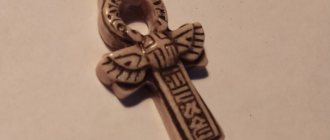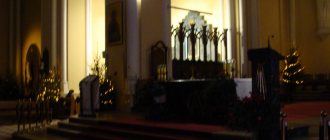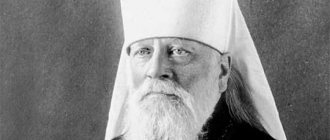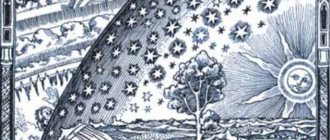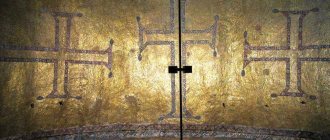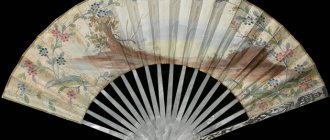Image of Chrisma
The earliest image of Chrisma is also similar to the pagan symbols that were the signs of Assyrian warriors. The wheel with six spokes can be compared to the wheel of God Jupiter. You can see a cross on the product, which indicates that the product can be used as a talisman. Considering the duality of the amulet, we can say that such jewelry is suitable for people who need protection from aggression. Six-rayed stars called Gromovnik connect a person with the Divine. This sign was a talisman and was depicted on military shields.
What are Christian symbols for?
A symbol is a common variable image that denotes a multi-valued image, concept, idea or phenomenon. A sign is a generally accepted image to indicate a specific meaning. There are a large number of different symbols in Christianity. The first believers used Christian symbols during times of persecution, when images of Jesus Christ were prohibited. For example, similar symbols were found in Roman catacombs. In ancient times they served as a refuge for persecuted Christians.
The vine is one of the Christian symbols
Christian symbols serve as an outward, visible expression of faith. The infinite, incomprehensible God and His attributes cannot be fully expressed in words or images. Therefore, Christians resort to various images and symbols. In ancient times, this was especially appropriate for introducing simple, unprepared people to the basics of Christian doctrine. Many symbols of Orthodoxy are depicted on icons. For example, the Holy Spirit is represented as a dove in icons of the Epiphany.
Victory Banner
Before his battle, Emperor Constantine the Great saw the Cross in the sky. He thought for a long time about what this could mean. That same night he had a dream in which Christ appeared. Christ told him to make a banner that would protect him from his enemies. This is how Labarum appeared, representing a cross, on top of which there was a wreath. Inside the wreath was the monogram of Christ.
Ad vocem
BREF Labarum is the name of the banner that the imp set for his troops. Constantine the Great, due to his vision of the sign of the cross in heaven (see). Not a single copy of L. has survived until later times. Judging by its depictions on various monuments, its form is varied in detail. Constantine's closest successors retained L.; Julian removed the monogram of I. Chr. from him, which was later restored again. According to the historian Socrates, the original labarum, as a relic, was kept in his time (about 430) in the palace of Constantinople, and according to Theophanes, it was seen there back in the 9th century. Those who wore L. were called dragonarians or vexilifers. The origin of the word L. is unknown (some pronounce it laborum).
“This thing had the appearance and shape of a military standard. She was crowned with a golden Latin cross. This cross was framed by a ring of precious stones; in the center of the circle these stones formed a monogram, the sacred letters XP. Hanging from the crossbar was a purple satin patterned fabric with the motto toytoi-nika and several exquisitely executed portraits. - My God, what is this? - Elena asked. - Don't you see? This is my Labarium... With this sign I won. “But, Constantine, I heard the story that you saw exactly this on the eve of the battle, and then you changed the signs on the soldiers’ shields and raised this sign on your standard. “Yes, that’s how it was.” Evelyn Waugh. "Elena".
Lactantium. Book to the confessor Donatus about the deaths of the persecutors XLIV (...) 5. And Constantine had a revelation (commonitus est) in a dream that he should depict the heavenly sign of God on his shields, and only then enter into battle. He did everything as ordered, depicting Christ on the shields with a letter curved at the top and crossed by the letter X. (translated by V. Tyulenev)
From the life of Constantine Chapter 28. About how, during prayer, he was rewarded with a vision from God, that is, in the middle of the day he saw in the sky a cross of light with an inscription commanding him to win. And he began to call on Him, ask and beg for Him to appear and enlighten him. about himself and in the upcoming work, he extended his right hand to him. Diligently offering his prayers and petitions about this, the basileus received the most amazing sign sent from God, so that it would not have been easy to believe if someone else had spoken. But the victorious basileus himself assured us of this with an oath, when, long after that, we wrote this essay and were honored with his acquaintance and conversation; therefore, who will doubt the truth of this legend, especially since subsequent times witnessed its truth? “Once, at midday, when the sun began to lean towards the west,” said the basileus, “with my own eyes I saw with my own eyes the sign of the cross made of light and lying in the sun with the inscription: “By this conquer!” This sight filled with horror both himself and the entire army, which, without knowing where, followed him and continued to contemplate the miracle that had appeared.
Chapter 29. About how Christ appeared to him in a dream and commanded him to have a banner depicting a cross in the war against his enemies, Constantine was, however, at a loss and said to himself: what would such a phenomenon mean? But while he was thinking and reflecting on it for a long time, night fell. Then the Christ of God appeared to him in a dream with a sign seen in heaven and commanded, having made a banner similar to the one seen in heaven, to use it for protection from the attacks of enemies. /// Lactantius (XLIV) reports on the monogram of Christ depicted on the shields of soldiers, while Lactantius places this event immediately before the battle of the Milvian Bridge. /// Chapter 30. Making such a sign of the cross Having risen with the onset of day, Constantine told his friends his secret and then, having called the craftsmen who knew how to handle gold and precious stones, he sat down between them and, having described to them the image of the banner, ordered, in imitation of him , make the same from gold and precious stones. We once happened to see this banner with our own eyes.
Chapter 31. Description of the cross-shaped banner, which the Romans now call a banner. It had the following appearance: on a long, gold-covered spear there was a transverse yard, which formed the sign of a cross with the spear. On top of the end of the spear lay motionless a wreath of precious stones and gold, and on it a symbol of the saving name: two letters showed the name of Christ, indicated by the first lines, from the middle of which came “R”. The basileus subsequently had the custom of wearing these letters on his helmet. Then, on a transverse yard nailed to the spear, hung a thin white cloth - royal fabric*, covered with various precious stones and sparkling with rays of light. Often embroidered in gold, this cloth seemed inexpressibly beautiful to spectators, hanging from a yardarm, it had the same width and length. On a straight spear, the lower end of which was very long, under the sign of the cross, at the very top of the described fabric, hung a chest image made of gold of the God-loving basileus and his children**. The basileus always used this saving banner, as a defensive weapon, to overcome opposing and hostile forces and ordered all troops to wear similar ones.
- Eusebius most likely refers to royal fabric as silk, which was very expensive and sold for its weight in gold. At this time, Constantine had only one eldest son, Crispus - Constantius and Constantine were born in 317, Constantine - in 322. Perhaps Eusebius describes the labarum in the form in which he himself saw it, already with the image of all the children of the emperor.
/// Instead of legion eagles. The description of the labarum itself in almost everything repeats the appearance of ordinary legionary badges - eagles, with one exception: instead of the eagle itself, on the top of the badge there is a monogram of Christ in a laurel wreath. /// (...) Chapter 37. Defeat of Maxentius’ troops in Italy Grieving over all this, Constantine armed himself against tyranny by all means. Having recognized the God of all and calling on His Christ as a savior and helper, also placing a victorious trophy with a saving banner in front of his hoplites and spearmen, he set out with his entire army on a campaign and decided to return to the Romans the freedom they had received from their ancestors. (...) Chapter 40. About his statue with a cross in his hands and about the inscription And he announced to all people about the saving banner through the great scripture and pillars, namely, in the midst of the royal city he erected this sacred symbol against the enemies and inscribed definitely and indelibly that this saving the banner is the guardian of the Roman land and the entire kingdom. When a statue of him was erected in the most crowded place in Rome, he immediately ordered that high spear in the form of a cross to be established in the hand of his image and the following inscription to be inscribed in Latin word for word: “With this saving sign, a true proof of courage, I saved and freed your the city from the yoke of the tyrant and, upon its liberation, returned the former splendor and glory to the Roman Senate and people.”
Christianity in Orthodoxy
The symbolism of Christianity is a manifestation of the vision of the world. Christianity in Orthodoxy expresses the eternity and perfection of the creator. The monogram of Christ is a symbol of the Sun, depicted in the shape of a wheel. It is the wheel that emphasizes the victorious nature of such a sign. The symbol of eternity is the ring. It lets us know that existence is eternal. If you understand the full meaning of such a sign, then you can find doubts here. A vertical line can represent the Cosmic Tree. There is evidence that shows that the Christogram existed even before the advent of Christianity. It was previously used by peoples as a symbol of the sun.
The cross comes to the fore in every Christogram. One of the features is that the Greek letters “P” and “T” are combined. If you delve into the designation, you can understand that “P” is the heavenly king, and “T” is the cross on which he was crucified. Before us is the symbol of the crucifixion.
Christianity is the basis of Christianity. Through this thing, God shows us processes with the help of symbols that carry power and energy.
Understanding what kind of life God lived is the basis of the teachings of the Orthodox faith, which is revealed through the Christogram.
By purchasing such a product, you acquire a spiritual symbol. The heritage of peoples, memory, tranquility, beauty, balance can be obtained in one bronze pendant. Such a pendant will definitely bring goodness and health into your life, and relieve bitterness and sadness.
Symbolic
Chrism (also called chrismon) is one of the main sacred emblems of early Christianity, which, according to some researchers, in its symbolism dates back to the pagan era. Graphically, the cross of chrisma is a monogram of the name of Christ, or more specifically, its Greek version - ΧΡΙΣΤΌΣ. That is, we are talking about combining the letters X (“chi”) and P (“rho”), which “overlap” each other. Christian theologians call this not “overlay,” but “re-baptism,” hence the phrase “cross of Christ.”
The most ancient images of chrism date back to the period BC; in particular, several coins with chrism from the era of Ptolemy III (ruled Egypt in the middle of the 3rd century BC) were discovered. However, the first official mentions of the cross of Christianity correspond to the first centuries of ours. The most famous image of the chrism is the labarum, this is the banner of the Roman Empire, on which the traditional chrism is located above the standard. The inscription on the banner under the chrism reads “With this you conquer” (“hoc vinces” in Latin).
The labarum with a pommel in the form of a cross of chrisma was introduced by Constantine the Great. Exact information about why Constantine chose this particular symbol has not been preserved, but a popular Christian legend claims that the emperor saw the chrism in the sky before the legendary battle of the Malvian Bridge (312). This battle brought Constantine sole and undisputed power over Rome. Historically, the first mention of the labarum of Constantine (and, accordingly, of the cross of chrisma) is found in the African rhetorician Lactantius in the year 320.
The symbol of Christianity has become widespread in Christian culture. It is found on banknotes (coins of Emperor Magnetius), on bas-reliefs of funeral sarcophagi (Rome, 3rd-5th centuries), on gravestones (an image of the cross of Chrism can be found in the Smolensk cemetery in St. Petersburg), as well as on individual religious emblems (on the flag of the Japanese Orthodox Church). At the same time, initially the Christian cross looked exactly like this - the combined letters X and P, without any additional elements. However, the newer images also contain the Greek letters "α" and "ω", which is an obvious reference to the Apocalypse (Revelation John 22:13 "I am Alpha and Omega, the beginning and the end").
Some theologians connect the emergence of Christianity with another fragment of the Apocalypse, which mentions a certain “seal of the living God” (Revelation from John 7:2, probably a reference to Jesus Christ). However, it is impossible to determine exactly when exactly the letters “alpha” and “omega” appeared on the chrism, but it is known that the original symbol did not have additional graphic elements. In addition, there is no doubt that the cross of Chrism is a purely Christian esoteric emblem, since images of Chrism were actively used by early Christians in southern Europe and before this period this symbol was not found at all.
There are many versions about the origin of Christianity. Hypotheses are put forward according to which the cross of Constantine arose from the symbolism of the Orphic and Gilios mysteries, or as a result of the synthesis of early Christian cults with the ritual symbolism of the beliefs of the Chaldeans. But there are also more prosaic assumptions, according to which the monogram of the letters “chi” and “rho” goes back to the Greek word “chrestos”, which means “auspicious”. There is no generally accepted version and it is unlikely that it will ever be possible to shed light on the real origin of this sign.
Alpha and Omega in banknotes
If you look closely at the designations of banknotes, it becomes clear that they represent certain symbols. What do these signs mean? After all, when inventing currency, the authors probably wanted it to flourish in the future.
Alpha and omega as a symbol are often found in many banknotes. In addition to them, you can find traces of yin and yang, the number Pi and more.
The clear alpha is the British pound sterling.
The American dollar and the Israeli shekel have yin and yang lines, and the Chinese currency has the number Pi.
Perhaps a country that has its own currency symbol in the outline of Omega will have its own special role to play?
Illustrations
A cross topped with a Chi-Rho monogram framed by a laurel wreath. Lateran sarcophagus. Central panel, 4th century, found at the catacombs of Domitilla (Rome), Lateran Museum. The figures of sleeping soldiers indicate that the image serves as a symbol of the victorious Resurrection of Christ. Source: New Catholic Encyclopedia (1967) Vol. IV p. 476.
Emperor Honorius holding a labarum. Ivory plate, diptych from the Cathedral of Aosta, Italy. Source: New Catholic Encyclopedia (1967) Vol. VIII p. 275, 276.
INNOMINE XPI.VINCAS SEMPER
- There is a so-called “Basque cross” or Lauburu is a traditional swastika symbol, the oldest images of which date back to the 2nd century (M. Camille Jullian in his preface to La tombe basque, according to Lauburu: La swástika rectilínea (Auñamendi Entziklopedia).), but whose name is only reliably recorded in the 19th century 9 "Orotariko Euskal Hiztegia". Euskaltzindia. Retrieved January 12, 2013.)
- “The cult of the cross came to Europe along with the Kipchak Turks. The equilateral cross is the symbol of Tengri. Byzantium, borrowing from the Tengrians the rites of veneration of the Heavenly God and adapting Christianity to them, also adopted the cult of the cross. That is why in the 4th century an equilateral cross adorned the banners of Constantine. “Labarum” is a clear adaptation of the Turkic expression ala barim (ala barim ~ alabarim ~ alabarum ~ labarum ~ labarum). It is based on: ala (in the meaning of “evil thoughts”, “machines”) and barim (death), formed by a combination of the verb bar- (to disappear, die) + the affix -im. The translation of this expression - “the death of bad thoughts” - very accurately reflects the situation after which the little-known Greek Constantine became the Great Sovereign. Having the Turkic army behind us, it was not difficult to do this.” Murad Aji. "Europe, Turks, Great Steppe"
Christianity
The name “labarum” in the Christian environment gradually spread to any banner with an image of a cross on the panel or at the top.
Catholicism In church art, the labarum most often appears in the form of a banner topped with the cross of Constantine in a circle or wreath, for example, in medieval depictions of the Resurrection of Christ as a sign of his victory over death.
Attribute of the Lamb of God; St. Ansana, George of Cappadocia, Julian, Reparata, Ursula and Wenceslaus - as a symbol of triumph over sin and persecution.
Orthodoxy In church use, the labarum replaced the banner. In icon painting, angels and archangels are depicted with him. It consists of a long shaft with a crossbar from which a cloth descends with the first letters of the name of Jesus Christ or the word “agios” (holy, holy).





